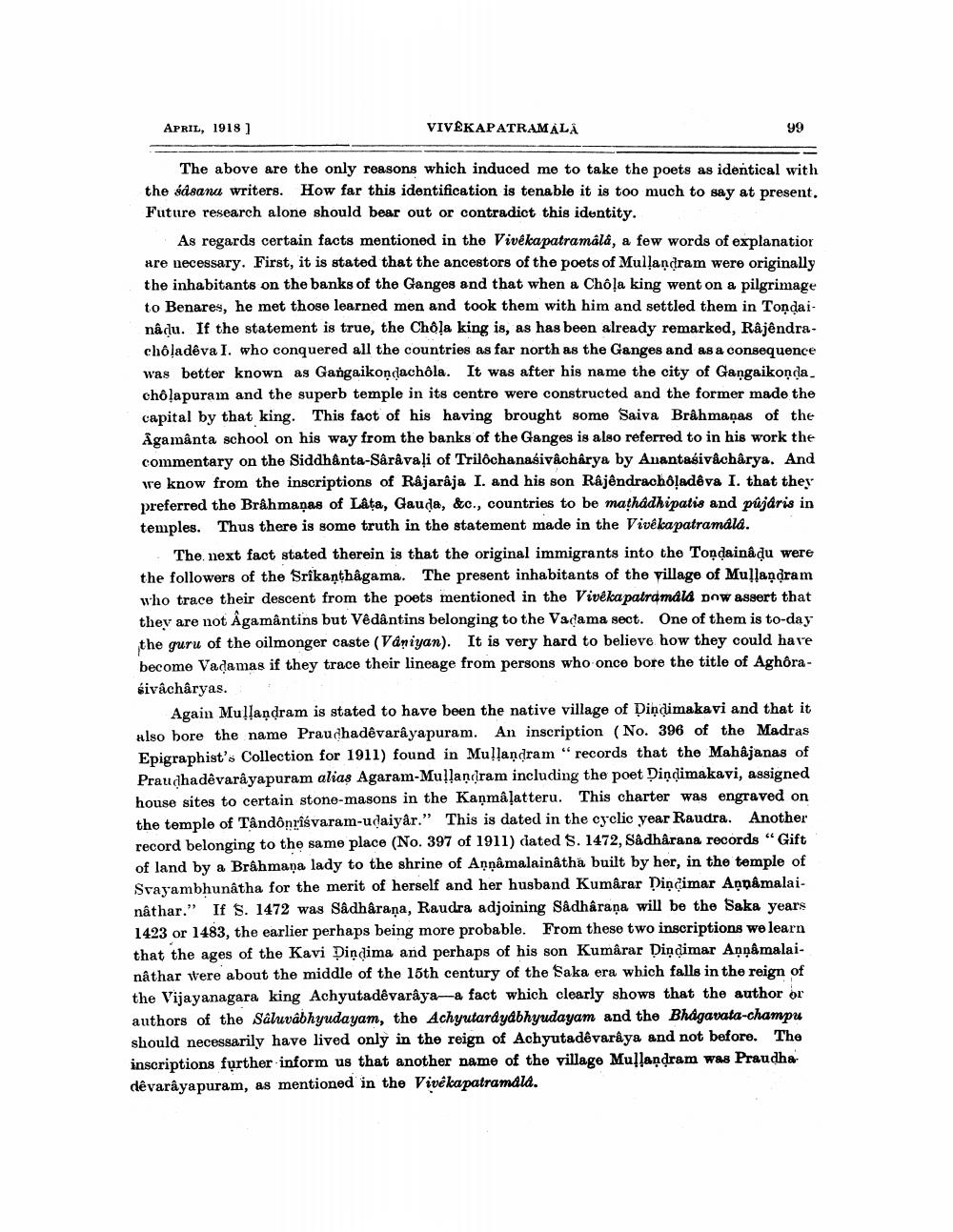________________
APRIL, 1918 ]
VIVEKAPATRAMALA
99
The above are the only reasons which induced me to take the poets as identical with the sdsana writers. How far this identification is tenable it is too much to say at present. Future research alone should bear out or contradict this identity.
As regards certain facts mentioned in the Viveka patramala, a few words of explanatior are necessary. First, it is stated that the ancestors of the poets of Mullandram were originally the inhabitants on the banks of the Ganges and that when a Chóļa king went on a pilgrimage to Benares, he met those learned men and took them with him and settled them in Toņdainâdu. If the statement is true, the Chola king is, as has been already remarked, Rajendrachôladeva I. who conquered all the countries as far north as the Ganges and as a consequence was better known as Gangaikondachôla. It was after his name the city of Gangaikonda. chôlapuram and the superb temple in its centre were constructed and the former made the capital by that king. This fact of his having brought some Saiva Brâhmaņas of the Agamânta school on his way from the banks of the Ganges is also referred to in his work the commentary on the Siddhanta-Sârâvali of Trilochanaśivacharya by Anantasivacharya. And we know from the inscriptions of Rajaraja I. and his son Rajendracho!adêva I. that they preferred the Brahmanas of Lata, Gauda, &c., countries to be mathadhipatis and půjdris in temples. Thus there is some truth in the statement made in the Vivêkapatramala.
The next fact stated therein is that the original immigrants into the Tondaina du were the followers of the Srikanthậgama. The present inhabitants of the village of Mullandram who trace their descent from the poets mentioned in the Viveka patramdla pow assert that they are not Ågamântins but Védântins belonging to the Vadama sect. One of them is to-day the guru of the oilmonger caste (Vaniyan). It is very hard to believe how they could have become Vadamas if they trace their lineage from persons who once bore the title of Aghorasivâchâryas.
Again Mullandram is stated to have been the native village of Dindimakavi and that it also bore the name Praudhadevarayapuram. An inscription (No. 396 of the Madras Epigraphist's Collection for 1911) found in Mullandram "records that the Mahajanas of Praudhadevarayapuram alias Agaram-Mul?andram including the poet Dindimakavi, assigned house sites to certain stone-masons in the Kaņmâļatteru. This charter was engraved on the temple of Tândônriśvaram-udaiyår." This is dated in the cyclic year Raudra. Another record belonging to the same place (No. 397 of 1911) dated S. 1472, Sådhårana records “Gift of land by a Brahmana lady to the shrine of Annamalainàtha built by her, in the temple of Svayambhunatha for the merit of herself and her husband Kumârar Dincimar Annamalainathar." If S. 1472 was Sådhåraņa, Raudra adjoining Sadharaṇa will be the Saka years 1423 or 1483, the earlier perhaps being more probable. From these two inscriptions we learn that the ages of the Kavi Dindima and perhaps of his son Kumarar Dişdimar Annamalainâthar were about the middle of the 15th century of the Saka era which falls in the reign of the Vijayanagara king Achyutadêvaraya-a fact which clearly shows that the author or authors of the Saluvâbhyudayam, the Achyutarayabhyudayam and the Bhagavata-champu should necessarily have lived only in the reign of Achyutadêvarêya and not before. The inscriptions further inform us that another name of the village Mullandram was Praudha devarayapuram, as mentioned in the Vivêkapatramaia.




